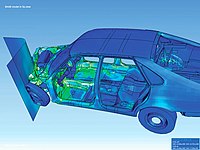
Photo from wikipedia
BACKGROUND Computational simulations of the E-field induced by transcranial magnetic stimulation (TMS) are increasingly used to understand its mechanisms and to inform its administration. However, characterization of the accuracy of… Click to show full abstract
BACKGROUND Computational simulations of the E-field induced by transcranial magnetic stimulation (TMS) are increasingly used to understand its mechanisms and to inform its administration. However, characterization of the accuracy of the simulation methods and the factors that affect it is lacking. OBJECTIVE To ensure the accuracy of TMS E-field simulations, we systematically quantify their numerical error and provide guidelines for their setup. METHOD We benchmark the accuracy of computational approaches that are commonly used for TMS E-field simulations, including the finite element method (FEM) with and without superconvergent patch recovery (SPR), boundary element method (BEM), finite difference method (FDM), and coil modeling methods. RESULTS To achieve cortical E-field error levels below 2%, the commonly used FDM and 1st order FEM require meshes with an average edge length below 0.4 mm, 1st order SPR-FEM requires edge lengths below 0.8 mm, and BEM and 2nd (or higher) order FEM require edge lengths below 2.9 mm. Coil models employing magnetic and current dipoles require at least 200 and 3000 dipoles, respectively. For thick solid-conductor coils and frequencies above 3 kHz, winding eddy currents may have to be modeled. CONCLUSION BEM, FDM, and FEM all converge to the same solution. Compared to the common FDM and 1st order FEM approaches, BEM and 2nd (or higher) order FEM require significantly lower mesh densities to achieve the same error level. In some cases, coil winding eddy-currents must be modeled. Both electric current dipole and magnetic dipole models of the coil current can be accurate with sufficiently fine discretization.
Journal Title: Brain stimulation
Year Published: 2019
Link to full text (if available)
Share on Social Media: Sign Up to like & get
recommendations!